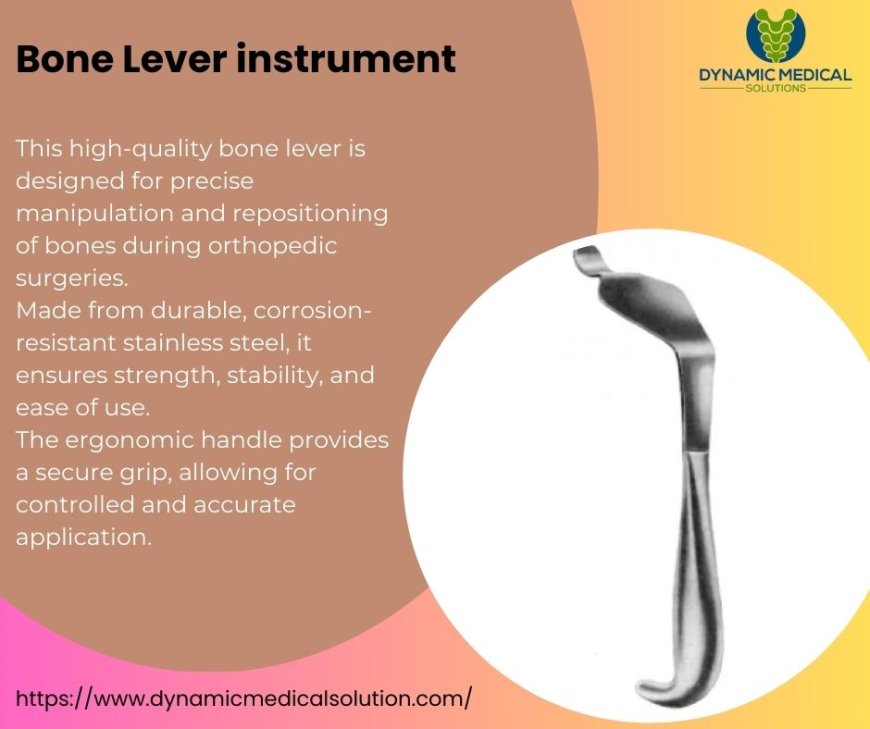Exploring the Different Types of Bone Lever Instruments in Surgery
This high-quality bone lever is designed for precise manipulation and repositioning of bones during orthopedic surgeries. Made from durable, corrosion-resistant stainless steel, it ensures strength, stability, and ease of use. The ergonomic handle provides a secure grip, allowing for controlled and accurate application. Suitable for a variety of surgical procedures, this instrument is a reliable choice for orthopedic surgeons and healthcare professionals.

Exploring the Different Types of Bone Lever Instruments in Surgery
Bone lever instruments are essential tools in orthopedic and surgical procedures, designed to provide the precision and stability required for effective bone manipulation. There are several types of bone levers, each with unique features tailored to specific surgical needs. This article highlights the various types of bone lever instruments and their applications in medical practice.
What is a Bone Lever Instrument?
A bone lever instrument is a specialized surgical tool used to lift, stabilize, reposition, or manipulate bones during various surgical procedures. Typically made from high-quality stainless steel, these instruments are known for their durability and ability to provide firm control during operations.
Types of Bone Lever Instruments
Different types of bone lever instruments are designed to meet the specific needs of diverse surgical scenarios. Below are the most commonly used types in the medical field:
1. Hohmann Bone Lever
The Hohmann bone lever is one of the most widely used types in orthopedic surgery. It features a flat, broad blade with a handle, allowing for effective leverage in lifting and retracting bones. This type is particularly useful in procedures involving long bones, such as femur or tibia surgeries, providing stability while reducing fractures or repositioning bones.
Key Features:
-
Broad blade for maximum surface contact.
-
Ideal for large bone manipulation.
-
Provides firm control and stability.
2. Bennett Bone Lever
The Bennett bone lever is another popular type, known for its unique design that includes a notched or curved blade. This design allows for greater control when retracting and stabilizing bones, making it ideal for spinal and pelvic surgeries. The notched blade ensures a secure grip on the bone, reducing the risk of slippage.
Key Features:
-
Notched blade for secure bone handling.
-
Suitable for delicate spinal adjustments.
-
Offers excellent control in confined surgical spaces.
3. Chandler Bone Lever
The Chandler bone lever is characterized by its rounded or curved blade, which makes it suitable for general orthopedic procedures. It is often used to lift bones gently and create space for other surgical instruments. Its versatility makes it a common choice in many types of bone surgeries.
Key Features:
-
Rounded blade for gentle bone lifting.
-
Versatile use in multiple surgical procedures.
-
Ideal for creating space during operations.
4. Stille Bone Lever
The Stille bone lever is designed for precision and control in delicate surgeries. It has a narrow, flat blade with a pointed tip, making it ideal for smaller bones and confined areas. This type of bone lever is commonly used in hand and foot surgeries, where accuracy is crucial.
Key Features:
-
Narrow blade with a pointed tip for precision.
-
Excellent for small bone manipulation.
-
Used in specialized surgeries like hand and foot operations.
5. Crabtree Bone Lever
The Crabtree bone lever has a distinctive shape with a curved, broad blade that is ideal for retracting soft tissues and stabilizing bones during surgery. This type is often employed in spinal and hip surgeries, where visibility and bone control are essential.
Key Features:
-
Curved, broad blade for effective retraction.
-
Excellent for stabilizing large bones.
-
Useful in deep surgical sites.
6. Freer Bone Lever
The Freer bone lever is a smaller, more delicate instrument used for fine adjustments and precision work. It is ideal for surgeries involving smaller bones, such as nasal or facial procedures. The thin blade allows for careful manipulation without causing unnecessary damage to surrounding tissues.
Key Features:
-
Thin blade for delicate adjustments.
-
Suitable for nasal and facial bone surgeries.
-
Provides gentle manipulation of small bones.
7. Sayre Bone Lever
The Sayre bone lever is designed with a short, flat blade and a sturdy handle, making it a preferred choice for orthopedic surgeries that require significant leverage. It is often used in procedures involving joint manipulation, where a firm grip and precise force are needed.
Key Features:
-
Short, flat blade for robust leverage.
-
Ideal for joint-related procedures.
-
Provides strong and controlled manipulation.
8. Farabeuf Bone Lever
The Farabeuf bone lever has a unique double-ended design, with two different blade shapes on each side. This versatility allows surgeons to choose the most appropriate end for the specific task at hand. It is commonly used in general orthopedic procedures for lifting and retracting bones.
Key Features:
-
Double-ended design for versatility.
-
Suitable for a variety of bone surgeries.
-
Easy to handle and maneuver.
9. Langenbeck Bone Lever
The Langenbeck bone lever is a long, slender instrument with a slightly curved blade. It is often used in deep surgical fields where access is challenging. Its long handle provides excellent leverage, making it suitable for abdominal and pelvic surgeries where bone adjustment is required.
Key Features:
-
Long, slender blade for deep surgical access.
-
Ideal for abdominal and pelvic surgeries.
-
Provides strong leverage in confined areas.
Conclusion: Choosing the Right Type of Bone Lever Instrument
The variety of bone lever instruments available highlights their importance in the surgical field. Each type has its specific role, designed to meet the unique demands of various surgical procedures. Whether it's the broad blade of a Hohmann bone lever for lifting large bones or the precise control of a Stille bone lever for delicate adjustments, selecting the right instrument is crucial for a successful surgical outcome. Bone lever instruments remain a cornerstone in orthopedic and general surgeries, providing surgeons with the tools they need to perform complex procedures with accuracy and care.For more info visit our web site Dynamic medical.
What's Your Reaction?














![Noots Focus Reviews [Truth Exposed 2025]!](https://news.bangboxonline.com/uploads/images/202501/image_430x256_678e3b94881a1.jpg)
![Vivalis Male Enhancement: The Must-Know Ingredients [2025 Update]](https://news.bangboxonline.com/uploads/images/202501/image_430x256_678e3b54e396c.jpg)









